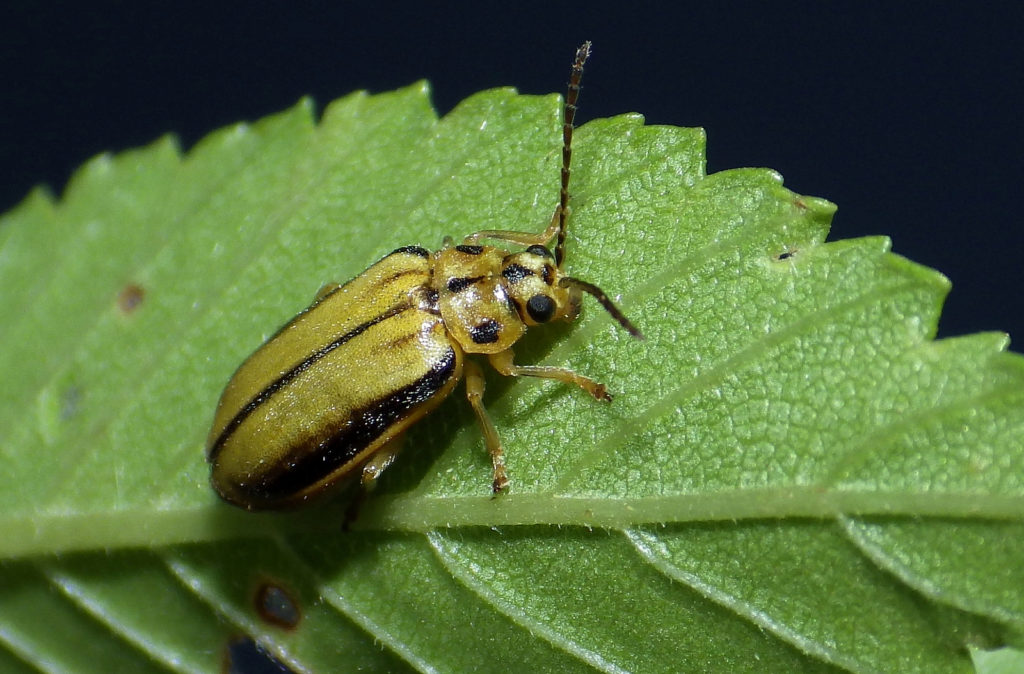Introduction
Elm leaf beetle (Xanthogaleruca luteola) is a significant nuisance of elm trees. It is a member of the family Chrysomelidae. Elm leaf beetle is indigenous to Europe. It was inadvertantly introduced to North America and Australia, where it has since become widespread. The adults and larvae feed on the foliage of elms. When populations are dense, elms may be completely defoliated. Repeated defoliation reduces tree vigor, and may result in tree mortality.
Distribution & Habitat
Elm leaf beetle ranges across Asia, Australia, Europe, and sections of North America. In North America, elm leaf beetle is most abundant in the Central and Eastern United States, where it is recognized as a serious defoliator of elms.
Hosts
Elm leaf beetle infests American elm, Chinese elm, English elm, Scots elm, Siberian elm, and Zelkova, as well as numerous cultivars. Landscape trees are typically more susceptible to infestation than those in forested settings.
Description
The adults are olive-green beetles with black, longitudinal stripes along the outer edge of each forewing, and the center of the back. When mature, the adults may extend up ¼ of an inch in diameter. The females lay orange-yellow eggs in double rows on the underside of leaves. The eggs turn gray prior to hatching. The larvae resemble caterpillars. They are black when newly hatched. As the larvae initiate feeding, their color brightens, transitioning from yellow to green. Dense rows of dark tubercles form on either side of the back, resembling two black stripes. Mature larvae can grow up 1/3 of an inch long. The pupa are orange to bright yellow.
Life Cycle
Elm leaf beetle passes through four stages during its life cycle: an egg stage, a larval stage, a pupal stage, and an adult stage. The adults overwinter in cracks, crotches, and bark crevices, as well as in woodpiles, and buildings. In spring, the adults resume activity. They fly to nearby elms, where they feed on the leaves, creating small, circular holes in the leaf surface. Once mature, the adults mate. The females subsequently lay 5 to 25 eggs on the underside of the elm leaves. Each female is capable of laying between 400 and 800 eggs during her life span.
A week later, the eggs hatch, revealing masses of larvae. The larvae commence feeding on the underside of the leaves that they have hatched onto. They feed vigorously for two to three weeks, gradually increasing in size. As the larvae feed, they skeletonize the foliage, leaving only the upper leaf surface and leaf veins intact. During this feeding period, the larvae progress through three instars. As the larvae reach maturity, they descend to the lower part of the tree, seeking out bark crevices and cracks in the trunk. Once they selected a suitable location, the mature larvae curl their bodies, and become sessile. Soon, the larvae enter pupation. Larvae will often pupate in large numbers around the tree base. Two to three weeks later, the adults emerge, and fly to the canopies of elm trees to feed. The females lay eggs throughout spring and summer. Depending on the geographic location, the adults may procuce two to three generations each year.
Symptoms of Infestation
The adults chew through leaves, creating small holes in the leaf surface. The larvae skeletonize the leaf surface. Damaged foliage will generally turn brown to white. Dense adult populations can partially or completely defoliate a large elm tree. This disrupts the photosynthetic process, impeding the tree’s ability to grow. Severely weakened trees are often bereft of growth. Trees that are defoliated will usually produce a second flush of growth, which may be readily consumed by subsequent generations of elm leaf beetle.
Management
- Maintain tree vigor through sound cultural practices. Ensure that elms are sufficiently watered, especially during periods of extended drought.
- Apply a layer of organic mulch around the base of trees. Proper mulching will improve the soil quality, conserve soil moisture, and moderate the soil temperature.
- Promptly remove any dead or diseased branches. Prune trees periodically to improve air circulation through the crown, and facilitate a rapid drying of the foliage.
- When planting, select cultivars that exhibit an increased resistance to elm leaf beetle.
- Elm leaf beetle has several natural predators, including certain flies, wasps, earwigs, lacewing larvae, and a predaceous ground beetle. The small black tachinid fly parasitizes the larvae. It lays its eggs in the larvae. Once the eggs have hatched, the larvae are devoured from within. The tiny wasp, Oomyzus gallerucae, feeds on the eggs.
- Tree trunks can be banded with insecticides. Banding elm trees can limit beetle populations by killing the larvae as they navigate down the main trunk prior to pupation.
- Buildings located close to infested trees should be sealed to prevent the beetles from overwintering in them.
- Systemic insecticides can be injected into the soil. Perform initial applications in spring, as leaf expansion begins.
Photo courtesy of Sarah Zukoff CC-by-2.0
